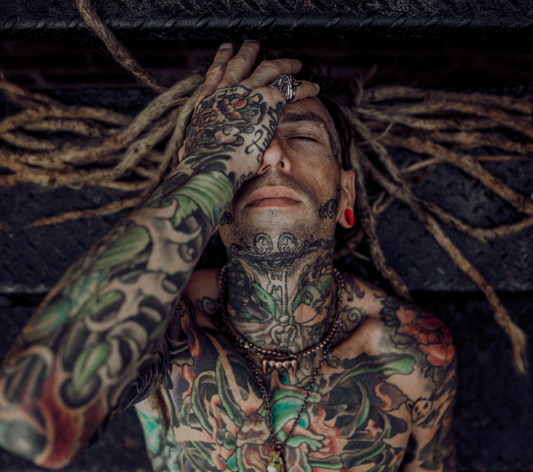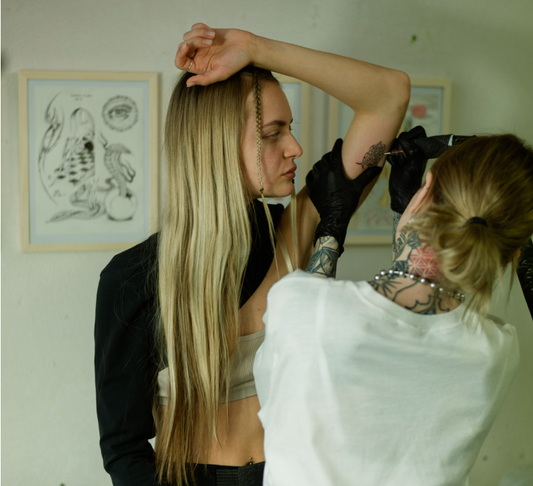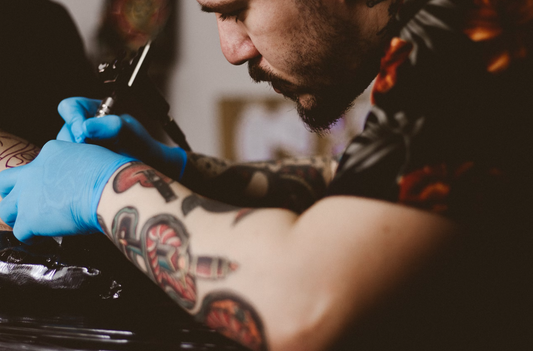Understanding Tattoo Healing: How Long Does it Take and Factors that Affect It
So, you've just gotten your new tattoo and you're wondering, "How long does it take for a tattoo to heal?" Well, I'm here to shed some light on that. It's no secret that healing times can vary significantly depending on various factors.
Factors such as the size and complexity of the tattoo, your body's ability to heal, and the care you provide during the healing process all play a crucial role. Let's dive in and explore these factors in more detail, so you can ensure your tattoo heals properly and looks great for years to come.
Remember, patience is key when it comes to tattoo healing. It's not a process to rush, but with the right knowledge and care, you'll be showing off your ink in no time.
Key Takeaways
- The healing time of a tattoo varies significantly based on factors such as size and complexity of the tattoo, your body's ability to heal, and the care provided during the healing process.
- The location of the tattoo, the tattoo artist's technique and tools, and your personal health and lifestyle also notably influence the healing speed.
- The tattoo healing process typically consists of four main stages: the initial healing stage, peeling and scabbing stage, itching and dryness stage, and the final healing stage.
- Following the aftercare instructions provided by your tattoo artist, keeping the tattoo clean and moisturized, avoiding picking or scratching the tattoo, and protecting the tattoo from sunlight and water are crucial for a faster and safer tattoo healing process.
- Potential complications such as infection, allergic reaction, excessive scarring, and premature tattoo fading or color loss can disrupt the healing timeline and need to be addressed promptly.
Factors Affecting Tattoo Healing Time
There's a lot that goes into how long it takes a tattoo to heal. Here are a few of those key factors.
Size and Complexity of the Tattoo
Naturally, the larger and more complex a tattoo is, the longer it'll take to heal. If it's a small, simple design, you may find that your healing time is much quicker. But, more intricate designs with a variety of colors require a longer healing period. That's because breaking up the design into multiple sessions allows your body time to heal before adding more ink. There's a higher risk of infection with larger tattoos as well, which could increase the recovery time.
Location of the Tattoo
The spot where you get your tattoo plays a role in how long it takes to heal too. If you've chosen an area where the skin is thin or sensitive, such as the inner arms or the neck, it might take a bit longer to heal. High-movement areas—think ankles, feet, or hands—also tend to heal slower due to frequent disturbance.
Artist's Technique and Tools
The tattoo artist's skill level and the tools they're using can affect the healing of your tat. If the artist pushes too deeply into the skin or uses a machine with high power, your post-tattoo recovery might be increased. An experienced tattoo artist will have a better understanding of skin depths and machine handling, resulting in a smoother healing process.
Personal Health and Lifestyle
Your personal health and lifestyle significantly influence the healing speed as well. If you're fit and healthy, your body is more likely to recover quickly from the trauma of tattooing. And let's not forget about lifestyle habits. Good hygiene, maintaining a balanced diet, getting plenty of sleep, and regulating alcohol intake can dramatically impact the pace of your tattoo's healing.
In essence, every person's tattoo healing time will differ, hinging on various factors that extend beyond what I've listed here. Predictably, having a heightened awareness of these elements will make for a better tattooing experience. Yet, what's most vital is patience: don't rush into getting that fresh ink out in the sun or diving into a hot tub—let nature take its course, and your new tat will be healed before you know it.
Stages of Tattoo Healing
After understanding the factors affecting the tattoo healing time, now let's delve into the components of a tattoo's healing process. The process generally consists of four main stages.
Initial Healing Stage
In the first few hours and days after getting a new tattoo, it'll go through the Initial Healing Stage. During this period, the area might be red, swollen, and a little bit sore, feeling much like sunburn. You might even see some excess ink or blood, which is completely normal. However, the excitement of a new design might often overshadow these discomforts. Remember, it's crucial to keep the tattooed area clean and follow an aftercare routine to prevent any infection.
Peeling and Scabbing Stage
The following stage, often after three to seven days post-tattooing, begins the peeling and scabbing phase. The skin starts to flake, much like a sunburn peel. There might also be small scabs forming over the tattoo. It's important to note that under no circumstances should you peel the skin or pick at the scabs; doing so could potentially damage the tattoo and hinder the healing process.
Itching and Dryness Stage
Next, during the Itching and Dryness Stage, resist the urge to scratch your tattoo. It may get extremely itchy as a sign of healing. The skin around the tattoo might become dry and taking lukewarm showers and applying a moisturizer can help alleviate the dryness. Again, you must not scratch or pick at the tattoo, as this can lead to discoloration or gaps in the ink.
Final Healing Stage
The last phase, the Final Healing Stage, generally two to four weeks after getting inked, the top layer of skin closes up and the tattoo might seem duller than before. But don't worry, this is also a normal part of the healing process, and the bright colors and clear lines should return once the skin fully heals from beneath.
Remember, patience and proper care are the keys to a successful tattoo healing process. It's natural for the timeline to vary based on the different factors discussed earlier. Most importantly, trust your body; it knows what it's doing. So avoid rushing the process, keep it clean and hydrated, and let nature take its course.
Tips for Faster Tattoo Healing
An important aspect for a smooth tattoo healing process is proper care and maintenance. While the body's natural healing mechanisms play a significant role, there are things we can consciously do to speed up the process without compromising the tattoo's final appearance. Below are a few tried-and-tested tips to ensure a faster and safer tattoo healing process.
Follow Aftercare Instructions
One of the first steps towards a successful tattoo healing process is to follow the aftercare instructions provided by your tattoo artist. These instructions usually include guidelines like keeping the tattoo clean, using the right type of ointment, and avoiding certain activities that can harm the tattoo.
Do not underestimate these instructions: adherence to them is vital for the proper healing of your tattoo. Your tattoo artist knows best what works for their particular style and the inks they use, so it's crucial to follow their advice to the letter.
Keep the Tattoo Clean and Moisturized
Maintaining hygiene around your tattoo is paramount. It's advisable to clean the area gently with a mild, fragrance-free soap and lukewarm water at least once a day, especially during the initial healing phase. Avoid using washcloths or towels as they can harbor bacteria.
Along with keeping the tattoo clean, maintaining adequate moisture levels is equally important. Keeping the tattooed skin moisturized is essential as it cultivates an ideal environment for the skin to heal. Dry, chapped skin tends to crack and flake, negatively affecting the tattoo's appearance.
Avoid Picking or Scratching the Tattoo
As your tattoo starts to heal, it's not uncommon for the skin to start itching and peeling away. However, it’s essential that you resist the urge to scratch or pick at the flaking skin or scabs.
If you interfere with this natural shedding process, you run the risk of causing unnecessary damage to your tattoo, prolonging the healing process, and possibly causing an infection. Instead of picking or scratching, apply a moisturizer to soothe the itch or slap the tattoo gently.
Protect the Tattoo from Sunlight and Water
UV exposure from the sun or tanning beds can have devastating effects on a healing tattoo. It's important to keep your tattoo protected from direct sunlight as this can lead to fading and distortion of the tattoo's colors.
As for water, soaking a new tattoo in pools, hot tubs, the ocean and even extended showers will have a harmful impact. The chemicals and bacteria can irritate the healing skin and potentially cause an infection.
Remember, patience is key to tattoo healing. Don't rush this process. Your body knows what it's doing. Follow these tips, and with time, you'll have a beautifully healed piece of art embedded in your skin.
Common Tattoo Healing Problems
While we've tackled the normal stages of healing and the necessary measures to hasten the process, it's important to note some potential complications that might come along the way. These common tattoo healing problems can sometimes disrupt the anticipated healing timeline and bring about discomfort or dissatisfaction with your body art.
Infection
Tattoo-induced infections can be nasty and alarming. Since the process involves puncturing the skin, it's essential to ensure sterilized equipment and a clean setting. The skin naturally accumulates bacteria. When this flora ends up in the open wound created by the tattoo needle, infections could easily ensue. Watch out for signs of infection like persistent pain, pus, excessive swelling, or redness. Any adverse changes to your usual body temperature can also be problematic. It's always best to consult a healthcare provider at the first sign of infection.
Allergic Reaction
Not everyone's body reacts the same towards tattoo ink. Some people might find themselves having an allergic reaction to the pigments used. This typically manifests as a rash or a series of bumps around the tattoo shortly after getting inked. Interestingly, it's not uncommon for these reactions to occur years after the tattoo has fully healed. Metallic-based inks, like reds and greens, are the most common culprits. Immediately get in touch with your doctor or dermatologist if you think you're experiencing a tattoo-related allergic reaction.
Excessive Scarring
We previously discussed that light scabbing is part of the healing process. Yet, when scarring becomes excessive and doesn't go away, it might be a case of hypertrophic or keloid scars. These terms describe injuries that create thick, raised scars disrupting the design and color of your tattoo. This excessive scarring happens due to your body's aggressive response to the injury. Those with a history of skin trauma or family history of keloid formation should inform their tattoo artists for pre-emptive measures.
Tattoo Fading or Color Loss
It's only natural for tattoos to fade over time. However, premature color loss can put a damper on that fresh ink you were excited about. Exposing the tattoo to intense sunlight and failing to moisturize properly can rapidly fade your tattoo’s colors. Using a sunscreen formulated for tattoos and regularly moisturizing with an approved product can help combat color fading.
As we continue to dive into the nuances of tattoo care, it's evident that understanding these potential issues can make a big difference in ensuring your tattoo heals properly and looks its best for years to come. Stay vigilant for these potential setbacks and remember to consult with trusted health professionals if faced with a situation you can't handle on your own.
Conclusion
Understanding tattoo healing times isn't a one-size-fits-all science. It's a process influenced by many factors such as tattoo size and complexity, location, and your personal health and lifestyle. Your tattoo's journey through the four main healing stages - initial healing, peeling and scabbing, itching and dryness, and final healing - requires your utmost care and patience. Be aware of common healing problems like infection, allergic reactions, scarring, and color loss. If you're ever in doubt, don't hesitate to seek help from a health professional. Remember, your tattoo's longevity and beauty rely on how well you manage its healing process.
What factors can affect the healing time of a tattoo?
The healing time of a tattoo can be influenced by several factors such as its size and complexity, the location on the body, the technique and tools used by the artist, and the individual's personal health and lifestyle.
What are the four main stages of the tattoo healing process?
The four stages of the tattoo healing process are the Initial Healing Stage, the Peeling and Scabbing Stage, the Itching and Dryness Stage, and the Final Healing Stage. Each stage requires proper care and patience.
What are the possible complications during the tattoo healing process?
Common complications during the tattoo healing process may include infection, allergic reactions, excessive scarring, and tattoo fading or color loss. It's crucial to be aware of these potential issues and seek medical attention when necessary.
Is it necessary to consult with health professionals if faced with tattoo healing problems?
Yes, it is advised to consult with trusted health professionals if you encounter any serious tattoo healing problems that you cannot handle on your own. This can prevent minor issues from becoming major health concerns.






